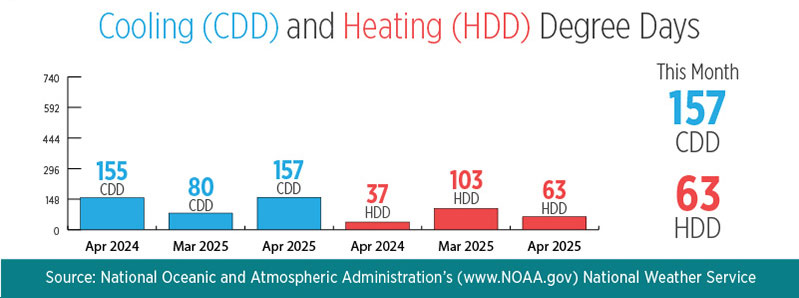What to expect on your May bill

North Texas received more than 5 inches of rain in April, 2 inches above normal. Most of the rain happened at the beginning and end of the month, keeping temperatures mild. But in between, temperatures went on quite the rollercoaster.
For CoServ Members, that means energy usage will be similar or slightly less than the month before, depending on the type of heater in your house.
If you have a gas heater, your natural gas usage will decrease but electricity will increase because of air condition use. Houses with electric heating will see similar usage as the heater decline is offset by an increase in air conditioning.
How do we quantify whether heating or air conditioning will increase? Utilities use a metric called Cooling Degree Days (CDD) and Heating Degree Days (HDD) to calculate this for days, weeks or months.
| March | April | Difference | |
| Average temperature | 64 | 67.9 | 3.9 degrees warmer |
| Heating Degree Days | 103 | 63 | 40 less HDD | Cooling Degree Days | 80 | 157 | 77 more CDD |
| Utilities and the federal government measure the impact of weather on energy usage by calculating Cooling Degree Days (CDD) and Heating Degree Days (HDD). To calculate the CDD, take the average temperature for a day and subtract it from 65. The higher the number, the more air conditioning will be needed to keep your home comfortable. Click here for more information on calculating CDD. | |||
As a shoulder month, April is notorious for wide temperature swings and this April was no different. Temperatures went from a high of 81 degrees on April 1 to a low of 40 degrees on April 7, then back up to a high of 93 degrees just six days later.
The average temperature for the month was 67.9, up 3.9 degrees from March. The average high temperature was 77.7 degrees, only 1.2 degrees higher than the previous month. The average low was 58.1, up 6.7 degrees from March.
Overall, there were 18 days with temperatures at 80 degrees or above, when air conditioning would likely be used, and four days at 45 degrees or lower when heaters could possibly be used. That leaves about 8 days where temperatures hovered around the sweet spot where no heating or air conditioning is needed.
Rates
For the 11th month in a row, CoServ maintained the Power Cost Recovery Factor (PCRF) as a negative number, meaning it subtracted from the base electricity rate. The PCRF will be -$0.005 for April billing.
The Standard Residential rate for May will be 12.73 cents per kilowatt-hour.
We make every effort to keep electricity rates affordable while delivering safe and reliable power to Members. When we save money by making strategic wholesale power purchases, we pass that on to Members, as we did this month.
Click here to learn more about how your CoServ rate is calculated.




